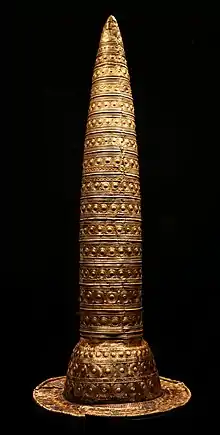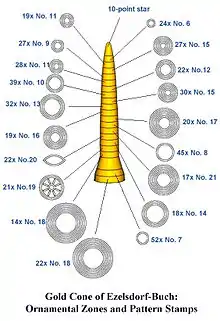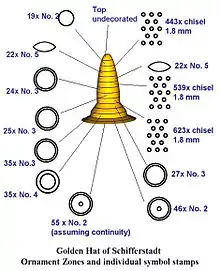Golden hat
Golden hats (or gold hats) (German: Goldhüte, singular: Goldhut) are a very specific and rare type of archaeological artifact from Bronze Age Europe. So far, four such objects ("cone-shaped gold hats of the Schifferstadt type") are known. The objects are made of thin sheet gold and were attached externally to long conical and brimmed headdresses which were probably made of some organic material and served to stabilise the external gold leaf. The following conical golden hats are known as of 2012:
- Avanton Gold Cone, incomplete, found at Avanton near Poitiers in 1844, c. 1400 BC.
- Golden Hat of Schifferstadt, found in 1835 at Schifferstadt near Speyer, c. 1400–1300 BC.
- Golden Cone of Ezelsdorf-Buch, found near Ezelsdorf near Nuremberg in 1953, c. 1000–900 BC; the tallest known specimen at c. 90 cm.
- Berlin Gold Hat, found probably in Swabia or Switzerland, c. 1000–800 BC; acquired by the Museum für Vor- und Frühgeschichte, Berlin, in 1996.
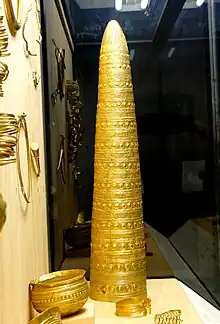
The archaeological contexts of the cones are not very clear (for the Berlin specimen, it is entirely unknown). At least two of the known examples (Berlin and Schifferstadt) appear to have been deliberately and carefully buried in antiquity.
Although none can be dated precisely, their technology suggests that they were probably made between 1400–800 BC.
Gallery
 Berlin, Neues Museum
Berlin, Neues Museum
 Ezelsdorf-Buch, Germanisches National Museum
Ezelsdorf-Buch, Germanisches National Museum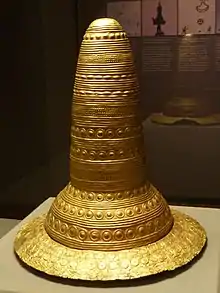 Schifferstadt, Historical Museum of the Palatinate
Schifferstadt, Historical Museum of the Palatinate
Cultural context
The hats are associated with the Bronze Age Tumulus culture and Urnfield culture. Their close similarities in symbolism and techniques of manufacture are testimony to a coherent Bronze Age culture over a wide-ranging territory in western and central Europe. A comparable golden pectoral was found at Mold, Flintshire, in northern Wales, which is of somewhat earlier date.
The cone-shaped golden hats of Schifferstadt type are assumed to be connected with a number of comparable cap or crown-shaped gold leaf objects from Ireland (Comerford Crown, discovered in 1692 and since lost) and the Atlantic coast of Spain (gold leaf crowns of Leiro and Axtroki), as well as various gold bowls (such as the Eberswalde Hoard), vessels, ornaments and diadems (such as the Velem diadem from Hungary) from across central and northern Europe. According to Sperber (2003) the Schifferstadt-type conical gold hats may have originated from contact with Atlantic Bronze Age cultures.[1]

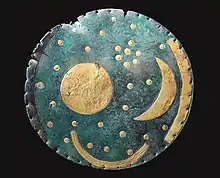 Nebra Sky Disc, Germany, c. 1800 BC
Nebra Sky Disc, Germany, c. 1800 BC Trundholm sun chariot, Denmark, c. 1500-1300 BC
Trundholm sun chariot, Denmark, c. 1500-1300 BC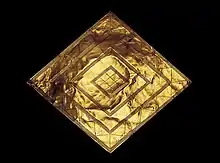 Bush Barrow gold lozenge, England, c. 1900 BC
Bush Barrow gold lozenge, England, c. 1900 BC
Function
It is assumed that the golden hats served as religious insignia for the deities or priests of a sun cult then widespread in Central Europe. Their use as headgear is strongly supported by the fact that the three of four examples have a cap-like widening at the bottom of the cone, and that their openings are oval (not round), with diameters and shapes roughly equivalent to those of a human skull. The figural depiction of an object resembling a conical hat on a stone slab of the King's Grave at Kivik, Southern Sweden, strongly supports their association with religion and cult, as does the fact that the known examples appear to have been deposited (buried) carefully.
Attempts to decipher the golden hats' ornamentation suggest that their cultic role is accompanied or complemented by their use as complex calendrical devices. Whether they were really used for such purposes, or simply presented the underlying astronomical knowledge, remains unknown.
Calendars
|
The gold cones are covered in bands of ornaments along their whole length and extent. The ornaments - mostly disks and concentric circles, sometimes wheels - were punched using stamps, rolls or combs. The older examples (Avanton, Schifferstadt) show a more restricted range of ornaments than the later ones.
It appears to be the case that the ornaments on all known golden hats represent systematic sequences in terms of number and types of ornaments per band.
A detailed study[3] of the Berlin example, which is fully preserved, claimed that the symbols possibly represent a lunisolar calendar. The object may have permitted the determination of dates or periods in both lunar and solar calendars.
Since an exact knowledge of the solar year was of special interest for the determination of religiously important events such as the summer and winter solstices, if astronomical knowledge was depicted on the Golden Hats it would have been of high value to Bronze Age society. Whether the hats themselves were indeed used for determining such dates, or whether they even represented such knowledge, remains unknown.
The functions hypothesized so far would permit the counting of temporal units of up to 57 lunar months. A simple multiplication of such values could also permit the calculation of longer periods, e.g. metonic cycles.
Each symbol, or each ring of a symbol, may represent a single day. Apart from ornament bands incorporating differing numbers of rings there are seemingly special symbols and zones in intercalary areas, which may have had to be added to or subtracted from the periods in question.
The system of this mathematical function incorporated into the artistic ornamentation has not been fully deciphered so far, but a schematic study of the Berlin Golden Hat and the periods it may delimit has been attempted.
In principle, according to this theory, starting with zone Zi , a sum is achieved by adding a relevant contiguous number of neighbouring sections: Zi ... Zi+n . To reach the equivalent lunar or solar value, from this initial sum must be subtracted the sum of symbols from the intercalary zone(s) within the area counted.

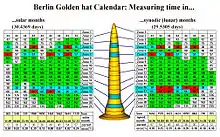
The illustration[4] depicts the solar representation on the left and the lunar one on the right. The red or blue fields in zones 5, 7, 16, and 17 are intercalary zones.
The values in the individual fields are reached by multiplying the number of symbols per zone with the number of rings or circles incorporated in each predominant symbol. The special symbols in zone 5 are assigned the value of "38", as indicated by their number.
(For example: Zone 12 is dominated by 20 repetitions of punched symbol No. 14, a circular disc symbol surrounded by 5 concentric circles. Thus, the symbol has the value of 20 × 5 = 100 . The smaller ring symbols placed between the larger repetitions of No. 14 are considered as mere ornaments and thus not counted.)
Through this system, the hats could be used to calculate a lunisolar calendar system, i.e. a direct reading in either lunar or solar dates, as well as the conversion between them.
The table can be used in the same way as the original Golden Hats may have been. To determine the number of days in a specific time period (yellow fields), the values of the coloured fields above are added, reaching an intermediate sum. If any of the red intercalary zones are included, their sum has to be subtracted. This allows the calculation of 12, 24, 36, 48, 54, and 57 synodic months in the lunar system and of 12, 18, 24, 36, 48, 54, and 57 solar months (i.e. twelfths of a tropical year).
(For example: To determine a 54 month cycle in the lunar system, the numerical values of the green or blue zones 3 to 21 are added, reaching a sum of 1,739 days. From this, the values of the red 'intercalary' fields 5, 16, and 17 are subtracted, The result is 1739 - 142 = 1597 days, or 54 synodic months of 29.5305 days each.)
The overall discrepancy of 2 days to the astronomically accurate value is probably the result of a slight imprecision in the Bronze Age observation of synodic and solar month.
Similar symbols are found on the gold bowls of the Eberswalde hoard. According to the Neues Museum, Berlin: “Gold vessels in the Eberswalde hoard bear sun and circular symbols like those on the Berlin gold hat. Some of these contain calendrical information as well."[5]
Manufacture
The golden hats known so far are made from a gold alloy containing 85–90% gold, about 10% silver and traces of copper and tin (< 1% each). They are made of seamless single pieces of gold sheet, hammered to a thinness between 0.25 millimetres (0.0098 in) (Schifferstadt) and 0.6 millimetres (0.024 in) (Berlin). Thus, the cones are surprisingly light considering their size. The Ezelsdorf example, measuring 89 centimetres (35 in) in height, weighs only 280 grams (9.9 oz).
Because of the tribological characteristics of the material, it tends to harden with increasing deformation (see ductility), increasing its potential to crack. To avoid cracking, an extremely even deformation would have been necessary. Additionally, the material would have had to be softened by repeatedly heating it to a temperature of at least 750 °C (1,380 °F).
Since gold alloy has a relatively low melting point of about 960 °C (1,760 °F), a very careful temperature control and an isothermal heating process would have been required, so as to avoid melting any of the surface. For this, the Bronze Age artisans presumably used a charcoal fire or oven similar to those used for pottery. The temperature could only be controlled through the addition of air, using a bellows.
Considering the tribologic conditions and the technical means available at the time, the production even of an undecorated golden hat would represent an immense technical achievement.
In the course of their further manufacture, the golden hats were embellished with rows of radial ornamental bands, chased into the metal. To make this possible, they were probably filled with a putty or pitch based on tree resin and wax; in the Schifferstadt specimen, traces of this have survived. The thin gold leaf was structured by chasing: stamp-like tools or moulds depicting the individual symbols were repeatedly pressed into (or rolled along) the exterior of the gold. Combs were also used.
Similar artefacts

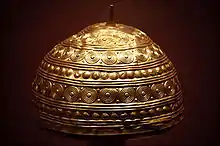 Gold Casco de Leiro, Galicia (Spain), 1400-1300 BC
Gold Casco de Leiro, Galicia (Spain), 1400-1300 BC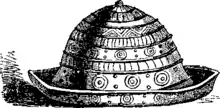 Gold Commerford Crown, Ireland
Gold Commerford Crown, Ireland
 Eberswalde Hoard gold bowls, Germany
Eberswalde Hoard gold bowls, Germany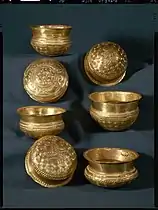
_01.jpg.webp)



.jpg.webp)


Exhibitions
The golden hats were first brought together for comparison and set in the broader context of the culture of Bronze Age Europe in a 1999 exhibition in Bonn, Gods and heroes of the Bronze Age: Europe in the time of Odysseus. Normally they reside in separate museums, at Berlin (Museum für Vor- und Frühgeschichte), Speyer (Historisches Museum der Pfalz, the Schifferstadt specimen), Nuremberg (Germanisches Nationalmuseum, the Ezelsdorf one), and Saint-Germain-en-Laye (Musée d'Archéologie Nationale).
See also
- Nebra sky disk, another Central European metal object from the Bronze Age expressing advanced knowledge of astronomy, between 1700 and 2100 BC.
- Pointed hat
- Trundholm sun chariot
- Tumulus culture
- Urnfield culture
- List of hats and headgear
- Casco de Leiro, a Bronze Age gold helmet from Galicia, NW Iberia
References
- Sperber, Lothar (2003). Springer, Tobias (ed.). Gold und Kult der Bronzezeit. Germanisches Nationalmuseum, Nuremberg. p. 211. ISBN 3-926982-95-0.
Die spezifische Form der Goldhüte vom Typus Schifferstadt und ihre Konzentration auf die westliche ürnenfelderkultur und ihre mittelbronzezeitlichen Vorläufer ist damit noch nicht erklärt. Hier hilft vielleicht ein typologischer Aspekt weiter. Denn rein formal kann der Typus Schifferstadt als Synthese der kalottenförmigen Goldhüte der atlantischen Bronzezeitkulturen und der rein kegelförmigen Zeremonialhüte mit Krempe, wie sie durch den nordischen Typus Kivik (Abb. 3, 4) und durch die Priesterstatuetten der Nuraghen-Kultur Sardiniens (Abb. 7, 8) überliefert sind, gesehen werden. Stimmt dies, dann entstand der Typus der Goldhüte von Schifferstadt und »Berlin« im Kontakt mit den atlantischen Bronzezeitkulturen und im Raum der westlichen ürnenfelderkultur, das heißt am ehesten auf zentralfranzösischem Gebiet oder, genereller gesagt, westlich des Rheins." English translation: "The specific form of the gold hats of the Schifferstadt type and their concentration on the western Urnfield culture and its Middle Bronze Age predecessors is thus not yet clear. Here perhaps a typological aspect helps further. From a purely formal point of view, the Schifferstadt type can be seen as a synthesis of the dome-shaped gold hats of the Atlantic Bronze Age cultures and the purely conical ceremonial hats with brim, as they have been handed down by the Nordic Kivik type and by the priestly statuettes of the Nuragic culture of Sardinia. If this is correct, then the type of the gold hats of Schifferstadt and "Berlin" originated in contact with the Atlantic Bronze Age cultures and in the area of the western Urnfield culture, that is most likely in central French territory or, more generally, west of the Rhine.
- Needham, Stuart (September 2000). "The Development of Embossed Goldwork in Bronze Age Europe". The Antiquaries Journal. 80 (1): 27–65. doi:10.1017/S0003581500050186. S2CID 162992985.
- Menghin (2000), see bibliography
- Source: Menghin (2000)
- "Life and Belief During the Bronze Age" Neues Museum, Berlin". Retrieved 13 March 2022.
- "Avanton Cone" Musée d'Archaeologie Nationale, Paris". Retrieved 8 April 2022.
Il est assez significatif que le seul cône dont le contexte archéologique nous soit connu, le chapeau de Schifferstadt, ait été découvert associé à trois haches à talon, organisées de façon rayonnante sur le rebord du chapeau, le talon délicatement posé en appui contre la calotte centrale, selon une composition qui ne doit rien au hasard. On retrouve cette combinaison cône/haches sur certaines stèles gravées d'Europe du Nord notamment à Kivik en Suède." English translation: "It is quite significant that the only cone whose archaeological context is known to us, the Schifferstadt hat, was discovered associated with three heel axes, arranged in a radial manner on the brim of the hat, the heel delicately resting against the central cap, in a composition that owes nothing to chance. One finds this cone/axe combination on certain engraved stelae of Northern Europe, notably at Kivik in Sweden.
- Sperber, Lothar (2003). Springer, Tobias (ed.). Gold und Kult der Bronzezeit. Germanisches Nationalmuseum, Nuremberg. pp. 215–216. ISBN 3-926982-95-0.
das Grab von Kivik einerseits durchaus den Schwertträgergräbern der Nordischen Bronzezeit entsprich. Andererseits verweist der einzigartige Bild- und Symbolzyklus seiner Grabkammer auf eine besondere religiöse Dimension. Eröffnet wird die Bildreihe mit der emblematischen Darstellung eines Kegelhutes zwischen zwei Zeremonialäxten. Die Vermutung liegt nahe, dass der Grabherr zu Lebzeiten nicht nur durch das Statussymbol des Schwertes ausgezeichnet war, sondern auch durch den priesterlichen Kegelhut und Zeremonialäxte und somit auch speziell priesterliche Funktion innehatte. [...] Die gleiche enge Verbindung von profanem, durch das Schwert symbolisiertem Adel und speziell priesterlicher Funktion ist auch auf einigen Felsbildern der Region Bohusiän in Schweden zu finden. Sie zeigen schwertgerüstete Personen, angetan mit dem hohen Kegelhut und beide Arme im Betergestus erhoben. Hervorzuheben ist dabei das kleine Felsbild von Gatemarken, das durch das »Beilklingen«-Symbol, kombiniert mit dem Radsymbol, ganz speziell mit dem Grab von Kivik verbunden ist." English translation: "On the one hand, the tomb of Kivik corresponds to the sword-bearer tombs of the Nordic Bronze Age. On the other hand, the unique pictorial and symbolic cycle of its burial chamber points to a special religious dimension. The series of pictures opens with the emblematic representation of a conical hat between two ceremonial axes. The assumption suggests that the tomb lord was distinguished during his lifetime not only by the status symbol of the sword, but also by the priestly conical hat and ceremonial axes and thus also held specifically priestly functions. [...] The same close connection of profane nobility symbolized by the sword and specifically priestly function is also found on some rock images of the Bohusiän region in Sweden. They show sword-armored persons, dressed with the high conical hat and both arms raised in prayer gesture. The small petroglyph of Gatemarken, which is specifically linked to the tomb of Kivik by the "axe blade" symbol combined with the wheel symbol, is noteworthy.
- Pasztor, Emilia (Spring 2015). "Symbols of Atmospheric Phenomena in Bronze Age Depictions". Hungarian Archaeology e-Journal.
a very important symbol consisting of five circles, for which there are numerous known analogies ... can be found on the famous, so-called Golden Cone of Ezelsdorf-Buch or the Berlin Gold Hat, both from the Late Bronze Age (14th–8th centuries B.C.), as well as on the famous gold diadem from one of the Mycenaean shaft graves
- Hansen, Rahlf; Rink, Christine (2008). "Kalender und Finsternisse - einige Überlegungen zur bronzezeitlichen Astronomie". In Wolfschmidt, Gudrun (ed.). Prähistorische Astronomie und Ethnoastronomie. Norderstedt bei Hamburg: Books on Demand. pp. 401–431. ISBN 978-3-8370-3131-7.
- Hansen, Rahlf; Rink, Christine (2014). "Die Zahlenkombination 32/33 als Indikator für einen plejadengeschalteten Lunisolarkalender". In Wolfschmidt, Gudrun (ed.). Der Himmel über Tübingen. tredition GmbH. pp. 401–431. ISBN 978-3-7323-1896-4.
- "Dýšina-Nová Huť. Gold disc with hammered decoration, Tumulus culture (1650-1250 BC)". Museum of West Bohemia in Pilsen.
- Bouzek, Jan (2018). Studies of Homeric Greece. Charles University. p. 205. ISBN 978-80-246-3561-3.
The West Bohemian gold roundels with twelve bosses are simplified calendars of the gold cones.
- "Two appliqués". National Museum of Slovenia. 2022.
These extraordinary appliqués were part of treasures deposited in the Bronze Age as an offering to gods on the shore of Lake Bled. The prestigious gold appliqués also indicate that the lake was an important centre of a cult. ... Similar appliqués have been discovered in Switzerland, Bavaria and Hungary, mainly in Bronze Age fortified settlements and in the graves of wealthy women. ... The ornamentation bears markings of the solar and lunar year.
- "Golden collar". Neues Museum, Berlin. Retrieved 13 March 2022.
There are three such gold collars in the museum, which are thought to be from three different hoards found close together. They were found together with gold wire and necklaces of bone and amber beads and shells. they are particularly important in terms of both crafting and cultural history and probably belonged to a woman of high social status. They are decorated with circular ornamentation and thus similar to the roughly contemporary Berlin Gold Hat and the Eberswalde golden bowls.
- Pasztor, Emilia (Spring 2015). "Symbols of Atmospheric Phenomena in Bronze Age Depictions". Hungarian Archaeology e-Journal.
finds have also come to light in Hungary that are similar from an archaeoastronomical perspective to the Nebra sky disk, or hold even more possibilities for scientific analysis. One example is the gold bracelet from Dunavecse ... Its system of motifs and symbols is much more complex and richer than that of the sky disk. Two solar disks can be clearly identified at the meeting point of the tendril-like curves, which either represent the arc of the crescent moon or the prow of a boat. Between the two solar disks there is a very important symbol consisting of five circles, for which there are numerous known analogies. This can be found on the famous, so-called Golden Cone of Ezelsdorf-Buch or the Berlin Gold Hat, both from the Late Bronze Age (14th–8th centuries B.C.), as well as on the famous gold diadem from one of the Mycenaean shaft graves, which was perhaps contemporaneous.
- "Golden Ceremonial Hat / Heegermühle disc". Neues Museum Berlin.
Other Bronze Age items prove that astronomical knowledge was often preseved in coded form on valuable and sacred objects. ... Especially impressive are the solar and lunar calendars numerically encoded in the ornamentation of the belt disc from Heegermühle in Brandenburg, Germany.
- "Heegermühle belt disc". Neues Museum Berlin.
Bibliography
- Gold und Kult der Bronzezeit. (Exhibition catalogue). Germanisches Nationalmuseum, Nürnberg 2003. ISBN 3-926982-95-0
- Wilfried Menghin (ed.): Acta Praehistorica et Archaeologica. Unze, Potsdam 32.2000, p. 31-108. ISSN 0341-1184
- Peter Schauer: Die Goldblechkegel der Bronzezeit – Ein Beitrag zur Kulturverbindung zwischen Orient und Mitteleuropa. Habelt, Bonn 1986. ISBN 3-7749-2238-1
- Gerhard Bott (ed.): Der Goldblechkegel von Ezelsdorf. (Exhibition cat.). Theiß, Stuttgart 1983. ISBN 3-8062-0390-3
- Mark Schmidt: Von Hüten, Kegeln und Kalendern oder Das blendende Licht des Orients. in: Ethnographisch-Archäologische Zeitschrift. Berlin 43.2002, p. 499-541. ISSN 0012-7477
- Werner Schröter, Karl-Friedrich Lebkücher, Alexander Koch (ed.), Lothar Sperber: Der Goldene Hut von Schifferstadt (Museum Book), Historisches Museum der Pfalz Speyer, Speyer 2008
External links
- Detailed information about the Ezelsdorf specimen (in German)
- Mysterious gold cones 'hats of ancient wizards' , Daily Telegraph, 17 March 2002. Retrieved 27 January 2016.
- The Golden Hat of Schifferstadt: An Astronomically Significant Deposit Location? (Amendola 2021)
